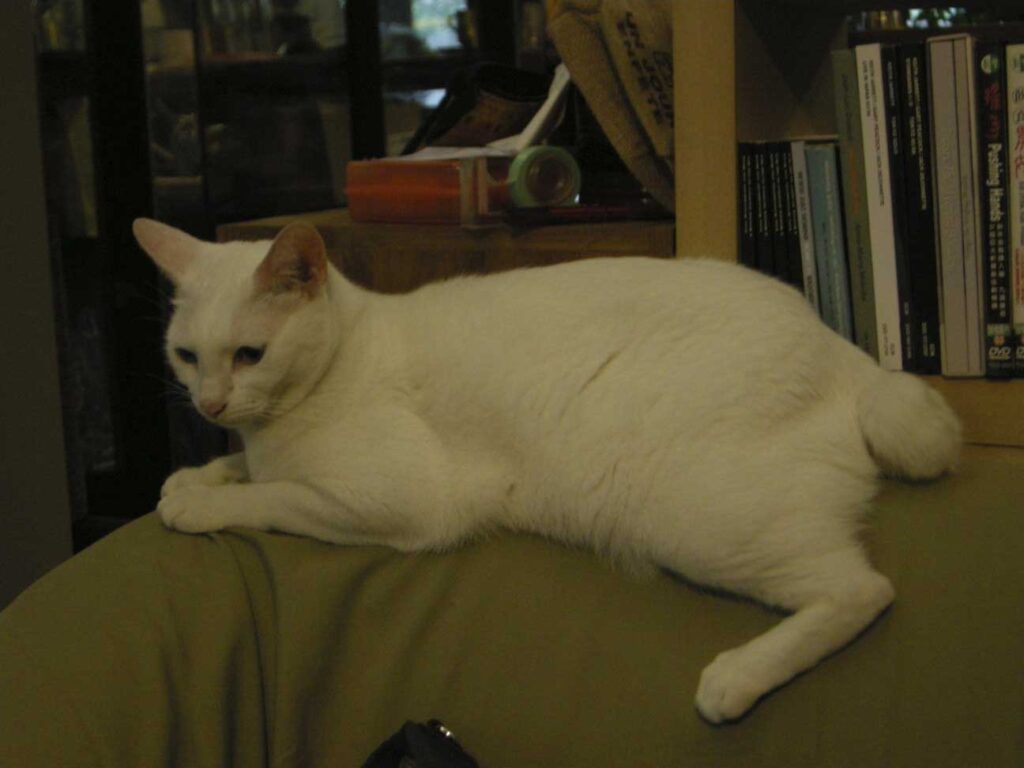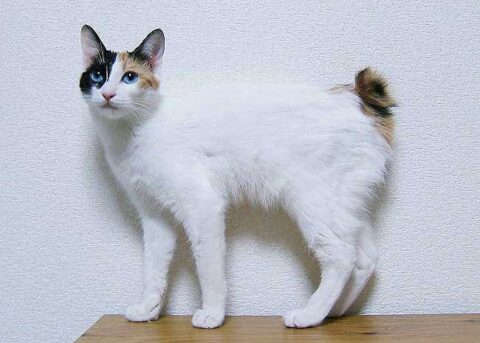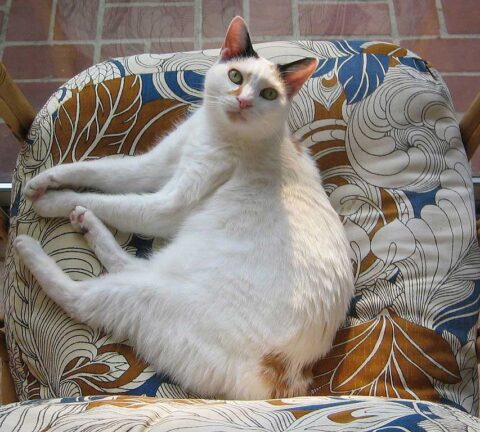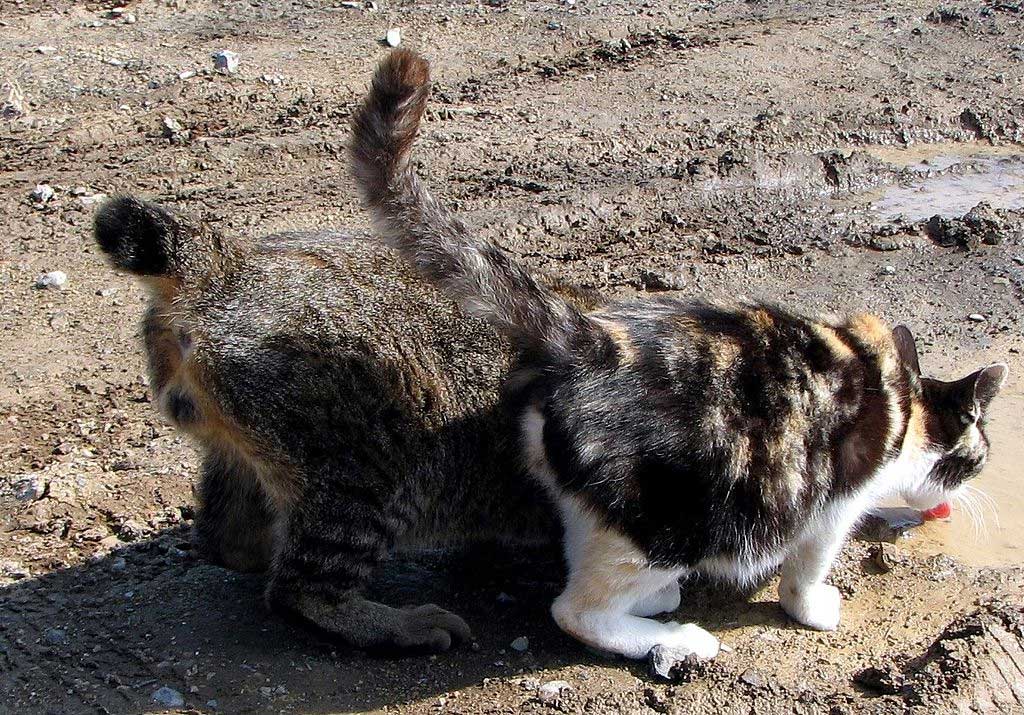
Content |
|---|
Characteristics "Japanese Bobtail"
Coexistence is important that you have with your new friend. Before considering the acquisition of a cat of the breed "Japanese Bobtail" you know certain factors. You must take into account their character, their need for exercise, their interaction with other pets, their care and if you have small children, their level of tolerance towards them.
Joy5.0 out of 5 stars (based on 1 review)
|
Activity level4.0 out of 5 stars (based on 1 review)
|
Friendliness to other pets3.0 out of 5 stars (based on 1 review)
|
|---|---|---|
Friendliness to children5.0 out of 5 stars (based on 1 review)
|
Grooming requirements2.0 out of 5 stars (based on 1 review)
|
Vocality4.0 out of 5 stars (based on 1 review)
|
Need for attention4.0 out of 5 stars (based on 1 review)
|
Affection towards its owners5.0 out of 5 stars (based on 1 review)
|
Docility4.0 out of 5 stars (based on 1 review)
|
Intelligence4.0 out of 5 stars (based on 1 review)
|
Independence2.0 out of 5 stars (based on 1 review)
|
Hardiness4.0 out of 5 stars (based on 1 review)
|
History
The Japanese Bobtail it owes its name to its very short, pom-pom-shaped tail, breed characteristic. There are two types: the Shorthair japanese bobtail and the Longhair Japanese Bobtail. Most official bodies consider that they are two varieties of the same breed., but the TICA (International Cat Association) consider each to be a breed in its own right.
The oldest records of this breed date back to the 6th century. But, despite its name, it likely actually originated from China or Korea. Some ancient Japanese texts say that the cat was initially gifted to the Emperor of Japan by the Emperor of China or Korea as a sign of friendship.. Another hypothesis is that Japanese Bobtail was brought to Japan by early Buddhist monks (who also came from Korea at the same time), as they used it to control rodents in order to protect the rice paper books and documents stored in the temples.
Whatever its origin, believed to be a natural breed, that is to say, not created or modified by the hand of man.
Originally, the Japanese Bobtail it was especially popular with silkworm farmers in Japan due to its incredible hunting skills. It allowed them to get rid of rodents forever.
The imperial family also quickly fell under the spell of the race, and granted privileges reserved to the nobility: all the care was given. In the 10th century, Emperor Idi-Jo even imported more copies from Korea to protect his manuscripts from small rodents.
In 1602, due to the invasion of rats that destroyed silkworm farms and rice crops, Japanese authorities decreed that cats should no longer be domesticated, they were allowed to roam freely through the farms and streets. Like this, feeding was prohibited, buy or sell cats. The Japanese Bobtail became the “street cat” of Japan.

It was not until many centuries later that the Japanese Bobtail became known outside of Asia. It was not the Japanese who made the breed official and gave it international recognition, but an American breeder named Judy Crawford, that brought several Bobtails japoneses of his trip to Japan in 1968. So he decided to join forces with Elizabeth Freret, another american breeder, to try to get the cat to be recognized by the different organizations. The breed was officially recognized by the CFA (Cat Fancier’s Association) in 1976, and by FIFe in 1990. Since then it has spread on American soil, and is now also recognized by the other two great American organizations, la American Cat Fanciers’ Association (ACFA) y la International Cat Association (TICA).
In France, owes its arrival to Hélène Choisnard, who discovered the breed during a stay in Thailand in 1980. While visiting a Buddhist temple, a monk gave him a young cat Japanese Bobtail tricolor called Sirikit, that had caught your attention. He took her to France and crossed her with another Japanese Bobtail that he had brought from the United States. Bobtails' first litter “made in France” was born a year later, in 1981. The breed is now recognized by the Livre Officiel des Origines Félines (LOOF), but it is still little known in Europe, where other short-tailed cats, as the Manx cat, they steal the show.
Physical characteristics
The Japanese Bobtail he is an athletic cat, medium-sized. Its body long and slender and his back straight, raised by legs tall and thin with feet oval, give it an unusual elegance. The neck it is harmonious and the legs strong despite their delicate appearance.

The head triangular, with clean lines and ears large, straight and spaced, is characterized by a forecrown rounded and prominent cheekbones, surrounding a nose long with two parallel lines. Its big eyes ovals are slanted and give a soft, tempered look. The eyes are often two different colors.
But what makes this breed special (and gives his name) is your tail short, tall and curled, which forms a kind of pompom. The Japanese see it as a chrysanthemum, good luck symbol according to japanese beliefs. This trait is derived from an autosomal gene. (that is to say, located on a non-sex chromosome; neither X nor Y) recessive and has no negative impact on the animal.
The fur of the Japanese Bobtail can be short or semi-long hair, with little undercoat in both cases. In any case, can be tortoiseshell or tortoiseshell. All cat coat colors are accepted, except for chocolate, the lilac, the cinnamon and the tawny. The tricolor coat, also called Mi-Ké (that means “Three hairs” in Japanese), is the most appreciated, as it is said to bring good luck to its owners. Last, to be accepted, color must be solid and deep or, when there are many colors, present pronounced contrasts.
Size and weight
- Male length: Of 30 – 35 cm.
- Female length: 30 – 35 cm.
- Male weight: 5 – 10 kg
- female weight 2,5 – 4 kg
Varieties
There are two varieties of Japanese Bobtail: the Shorthair japanese bobtail and the Longhair Japanese Bobtail. The latter was not recognized by the CFA (Association of amateurs of cats) until 1993, while the TICA considers it a feline breed in its own right.
Both cats have a silky coat with very little undercoat.
Character and skills
The Japanese Bobtail he is a smart cat, mischievous and very curious that exudes joy of living. very difficult to alter, is constantly alert and ready to discover everything new in the house. His curiosity leads him to explore every corner of his home, and allows you to easily adapt to new environments, which makes it a perfect travel companion.
Their outgoing character helps them express themselves and make themselves understood. It is a very talkative cat and will return the meow to whoever addresses it. It's not especially loud though, has a lot to say, And a whole host of meows and sounds at your disposal to say so!! Attached to its owner, can follow you all day without getting bored, but without showing his excessive meowing or his disturbing behavior.
It is possible to train your cat, since he is quite intelligent and playful by nature: can easily learn some tricks and understand some commands. You can even walk your cat on a leash, if you can make me see it as a game, so that you find it interesting. But, they can be stubborn, so sometimes it's hard to make them change their minds about certain things (for example, what they can and cannot do).
On the other hand, this cat is very laid back and can jump to impressive heights. Providing suitable perches or toys will encourage them to jump and exercise.
You should also make sure to give them a few minutes of play each day., since it is necessary for its development. It is a breed of cat that adapts well to children, whose energy and enthusiasm shares. Also easily accepts the presence of strangers and other animals. In the case of a dog, put them together little by little, if possible when the cat is still young, makes it easier for them to get along and coexist.
Last, the Japanese Bobtail it is one of the few breeds of cats that like water.

Health
The Japanese Bobtail you do not have any particular genetic disease. His athletic build makes him one of the most vigorous cats, and has a constitution of iron.
The life expectancy of the cat is approximately 15 years, making it one of the longest-lived cat breeds.
Life expectancy
13 to 16 years
Grooming
Due to its scarce undercoat, the fur of the Japanese Bobtail not prone to knots and, Therefore, requires relatively little maintenance.
In the case of a Shorthair japanese bobtail, a weekly brushing is usually sufficient. In the case of a Longhair Japanese Bobtail, daily brushing of the cat's coat, although it is not essential, will help the coat retain its beauty and shine. For both cases, the Japanese Bobtail seasonally molts, in spring and autumn. The long-haired variety is constantly shedding.
But, the Japanese Bobtail he is very playful when groomed. Unlike some of his peers, This is not usually a moment that I hate, All the more reason not to exempt him from it!!
The coat of the Japanese Bobtail it is waterproof, meaning bathing and shampooing can be difficult. Fortunately, these two tasks are rarely necessary.
It also, to prevent the build-up of tartar and the development of infections such as gingivitis, regular brushing of the cat's teeth is recommended. The ideal is daily brushing, but the weekly is fine.
Last, it is a good idea to check the condition of your cat's ears at regular intervals, and clean them if they look dirty.
For sale "Japanese Bobtail"
The price of adopting a kitten Japanese Bobtail usually oscillates between 800 and 1100 EUR. There is no big difference between the price of a kitten Japanese Bobtail male or female.
If you don't get a "Japanese Bobtail", You will always have the consolation of being able to buy the famous “Mancki-neko“, or cat who greets, a popular lucky charm very typical in Japan.
Videos "Japanese Bobtail"
|
Talking cats
|
Japanese Bobtail : Top 10 Facts About Japanese Bobtail Cats That Will Leave You Amazed
|
|---|
Alternative names:
1. Japanese Bobtail (English).
2. Bobtail japonais (French).
3. Japanese Bobtail (German).
4. Bobtail japonês (Portuguese).
5. "Bobtail japonés" (español).
